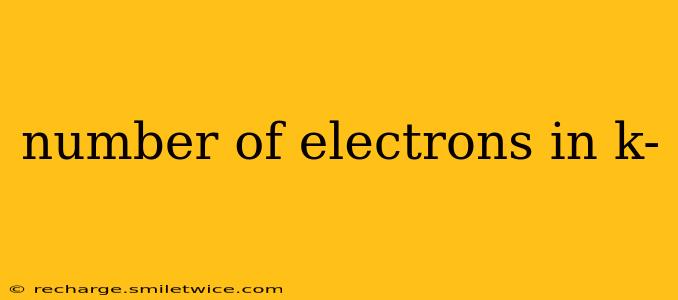The Number of Electrons in the K Shell: A Deep Dive into Atomic Structure
The K shell, also known as the first electron shell or energy level, is the closest shell to the nucleus of an atom. Understanding its electron capacity is fundamental to grasping atomic structure and chemical behavior. This post will explore the number of electrons the K shell can hold and delve into related concepts.
What is the K Shell?
Before we determine the electron count, let's clarify what the K shell represents. In an atom, electrons exist in specific energy levels, or shells, surrounding the nucleus. These shells are designated by letters: K, L, M, N, and so on, with K being the shell closest to the nucleus. Each shell can hold a maximum number of electrons, determined by a specific formula.
How Many Electrons Can the K Shell Hold?
The K shell can hold a maximum of two electrons. This is a fundamental rule in atomic structure. This capacity is defined by quantum mechanics, specifically the Pauli Exclusion Principle, which states that no two electrons in an atom can have the same set of four quantum numbers (principal quantum number, azimuthal quantum number, magnetic quantum number, and spin quantum number). The K shell, having only one subshell (the 1s subshell), can only accommodate two electrons with opposite spins.
Frequently Asked Questions (FAQs)
Here, we'll address some common questions surrounding the K shell and electron configuration:
1. Why can the K shell only hold two electrons?
The K shell's limited capacity stems from its single subshell, the 1s subshell. This subshell has only one orbital, and each orbital can accommodate a maximum of two electrons according to the Pauli Exclusion Principle. These electrons must have opposite spins (one spin-up and one spin-down).
2. What happens if an atom has more than two electrons?
If an atom has more than two electrons, the additional electrons will occupy higher energy levels (L, M, N, and so on). The electron configuration describes the arrangement of electrons in these shells and subshells, indicating the distribution of electrons across the different energy levels.
3. How does the number of electrons in the K shell affect the atom's properties?
The number of electrons in the K shell, along with the number of electrons in other shells, directly influences an atom's chemical properties and reactivity. Atoms tend to react in ways that achieve a stable electron configuration, often a filled outermost shell. For example, hydrogen and helium, with one and two electrons respectively filling the K shell, demonstrate very different chemical behavior.
4. Does the K shell always have two electrons?
No, the K shell doesn't always have two electrons. Hydrogen, for instance, only has one electron in its K shell. Helium, with two electrons in its K shell, has a complete and stable K shell. Elements beyond helium have more than two electrons, so only the first two electrons reside in the K shell.
5. How is the K shell relevant to X-ray production?
The K shell plays a crucial role in X-ray production. When a high-energy electron knocks an electron out of the K shell, an electron from a higher energy level falls down to fill the vacancy, releasing energy in the form of an X-ray photon. The energy of this photon is characteristic of the element and is used in techniques like X-ray fluorescence spectroscopy.
Conclusion:
The K shell's capacity to hold only two electrons is a cornerstone of atomic theory. This fundamental principle underpins our understanding of electron configuration, chemical bonding, and various spectroscopic techniques. This limited capacity directly influences an atom's properties and reactivity, making it a key concept in chemistry and physics. Understanding the K shell helps unlock a deeper appreciation of the intricate world of atomic structure.
